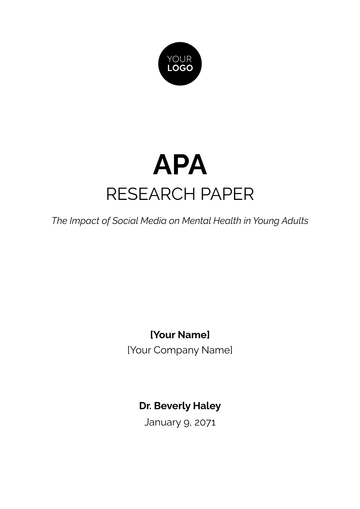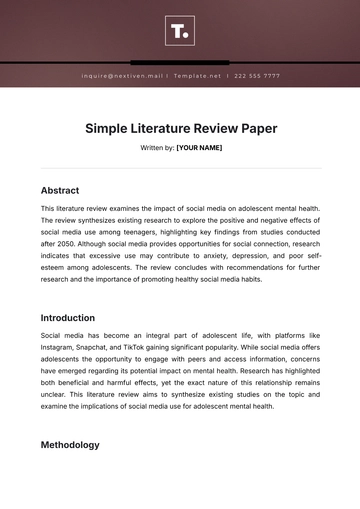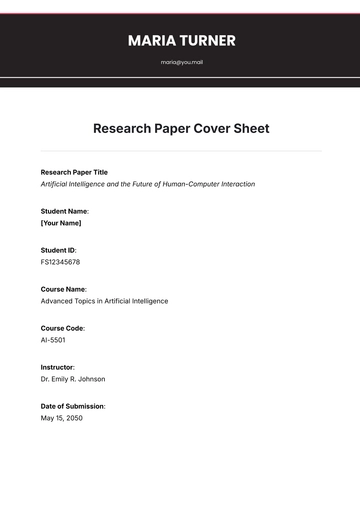Free Market Research Paper

Prepared By: [Your Name]
Company Name: [Your Company Name]
1. Introduction
1.1 Background
Market research is a critical component in understanding the dynamics of a specific industry. This research paper provides an in-depth analysis of market trends, consumer behaviors, and competitive landscapes. The insights presented are essential for businesses aiming to make informed decisions regarding their products, services, and market strategies.
1.2 Objectives
The objectives of this paper are to:
Identify and analyze current market trends and their implications.
Understand consumer behavior and preferences.
Assess the competitive landscape through a SWOT analysis.
Provide strategic recommendations based on research findings.
2. Methodology
2.1 Research Methods
The research employed a combination of qualitative and quantitative methods:
Surveys and Questionnaires: Distributed to a sample of 1,000 consumers to gather data on preferences and behaviors.
Secondary Data Analysis: Utilized industry reports, market studies, and financial data from reputable sources.
Expert Interviews: Conducted with 10 industry experts to gain insights into market dynamics and future trends.
2.2 Data Sources
Data was gathered from:
Market Research Databases: Such as Statista, IBISWorld, and Nielsen.
Industry Publications: Including reports from McKinsey & Company and Gartner.
Consumer Feedback: Collected through online surveys and focus groups.
Expert Consultations: Insights from industry analysts and thought leaders.
3. Market Trends
3.1 Technological Innovations
Technological advancements are transforming the market landscape. Key innovations include:
Artificial Intelligence (AI): Enhancing automation and personalization in various sectors.
Internet of Things (IoT): Facilitating smarter consumer products and improved data analytics.
Blockchain Technology: Increasing transparency and security in transactions.
3.2 Economic Shifts
Economic conditions are influencing market dynamics:
Inflation: Impacting consumer purchasing power and cost structures.
Economic Growth: Driving increased investment and market expansion.
Global Trade Policies: Affecting supply chains and international trade relationships.
3.3 Changing Consumer Preferences
Consumer preferences are evolving:
Sustainability: Growing demand for eco-friendly and ethically produced products.
Personalization: Increased desire for tailored experiences and customized products.
Convenience: Preference for seamless online shopping and fast delivery options.
3.4 Regulatory Changes
Regulatory changes are shaping market conditions:
Data Privacy Laws: Stricter regulations affecting data collection and usage.
Environmental Regulations: Mandates for sustainable practices and reduced carbon footprints.
Trade Policies: Tariffs and trade agreements influencing market access and costs.
4. Consumer Behaviors
4.1 Factors Affecting Consumer Behavior
Understanding consumer behavior involves analyzing various factors:
Psychological Factors: Includes motivation, perception, learning, beliefs, and attitudes that influence buying decisions.
Personal Factors: Factors such as age, occupation, economic situation, lifestyle, personality, and self-concept.
Social Factors: The impact of family, roles, status, and social networks on purchasing decisions.
Cultural Factors: Cultural values, subcultures, and social class that shape consumer preferences.
4.2 Consumer Insights
Key insights from consumer behavior analysis:
Online Shopping: High preference for digital platforms for convenience and variety.
Health and Wellness: Increasing interest in products promoting well-being and healthy lifestyles.
Brand Loyalty: Consumers are becoming more loyal to brands that align with their values and offer personalized experiences.
5. Competitive Landscape
To effectively navigate the competitive environment, it is essential to analyze the strengths, weaknesses, opportunities, and threats (SWOT) of key competitors. The following table provides a comprehensive SWOT analysis of prominent competitors in the market:
Competitor | Strengths | Weaknesses | Opportunities | Threats |
|---|---|---|---|---|
Competitor A | Established brand and large customer base | High production costs and limited innovation | Market expansion and new technologies | Economic downturn and new market entrants |
Competitor B | Innovative products and flexible model | Limited resources and low market share | Strategic partnerships and niche markets | Regulatory changes and price competition |
6. Detailed Findings and Analysis
6.1 Key Findings
Emerging Technologies: The integration of AI and IoT presents new opportunities for innovation and market differentiation.
Consumer Trends: A significant shift towards sustainable and personalized products is evident.
Competitive Strategies: Companies that embrace innovation and sustainability are better positioned to succeed.
6.2 Analysis
The analysis reveals:
Growth Opportunities: Sectors like technology and sustainability offer substantial growth potential.
Strategic Adjustments: Businesses must adapt to evolving consumer preferences and competitive pressures to maintain a competitive edge.
7. Recommendations
7.1 Strategic Recommendations
Invest in Digital Transformation: Enhance digital capabilities to meet the growing demand for online and personalized experiences.
Focus on Sustainability: Develop and promote eco-friendly products to align with consumer values and regulatory requirements.
Enhance Product Customization: Offer tailored products and services to cater to individual preferences and improve customer satisfaction.
7.2 Implementation Strategies
Develop a Digital Marketing Plan: Create targeted campaigns to engage with tech-savvy consumers and drive online sales.
Form Strategic Partnerships: Collaborate with sustainable suppliers and technology partners to enhance product offerings and market reach.
Regularly Review and Adapt Strategies: Continuously monitor market trends and competitor activities to adjust strategies accordingly.
8. Conclusion
Market research is vital for understanding and navigating the complexities of the market. This paper has provided a detailed analysis of market trends, consumer behaviors, and competitive dynamics. By leveraging these insights, businesses can make informed decisions and develop strategies to achieve their objectives.
- 100% Customizable, free editor
- Access 1 Million+ Templates, photo’s & graphics
- Download or share as a template
- Click and replace photos, graphics, text, backgrounds
- Resize, crop, AI write & more
- Access advanced editor
The Market Research Paper Template from Template.net is an editable and customizable solution for in-depth market analysis. Easily adjust this template to fit your research objectives, ensuring a thorough examination of market trends and consumer behavior. Perfect for both academic and professional use, this versatile template streamlines the research process, helping you create detailed and impactful market reports with ease and precision.





























